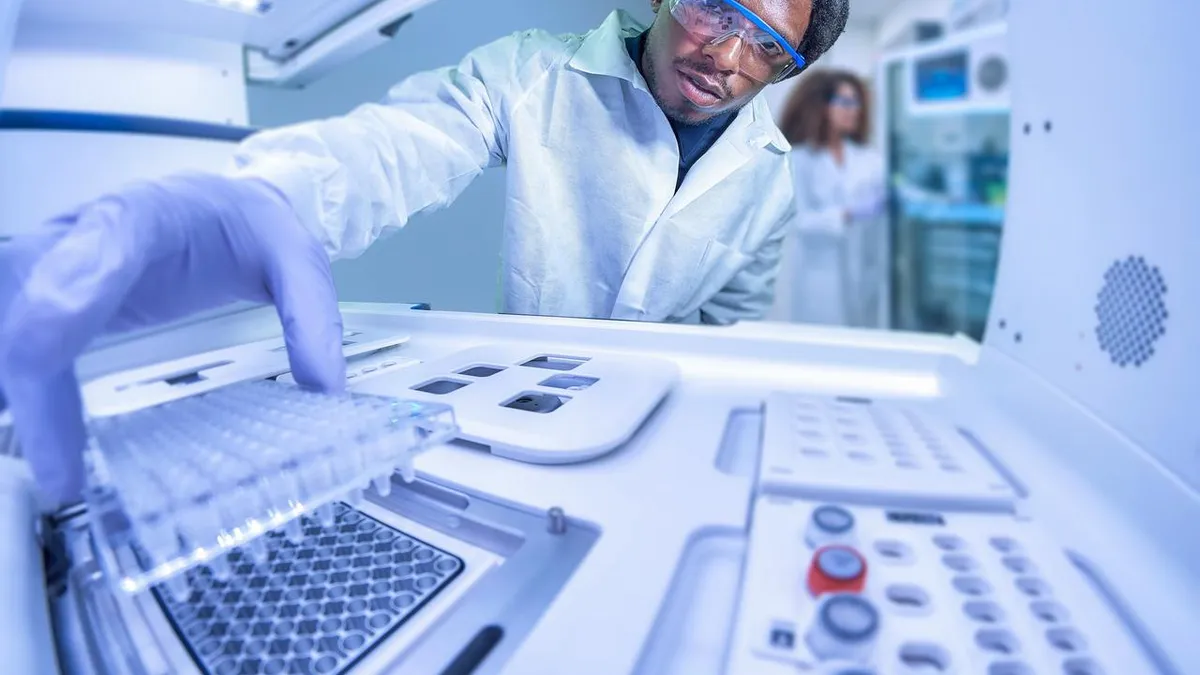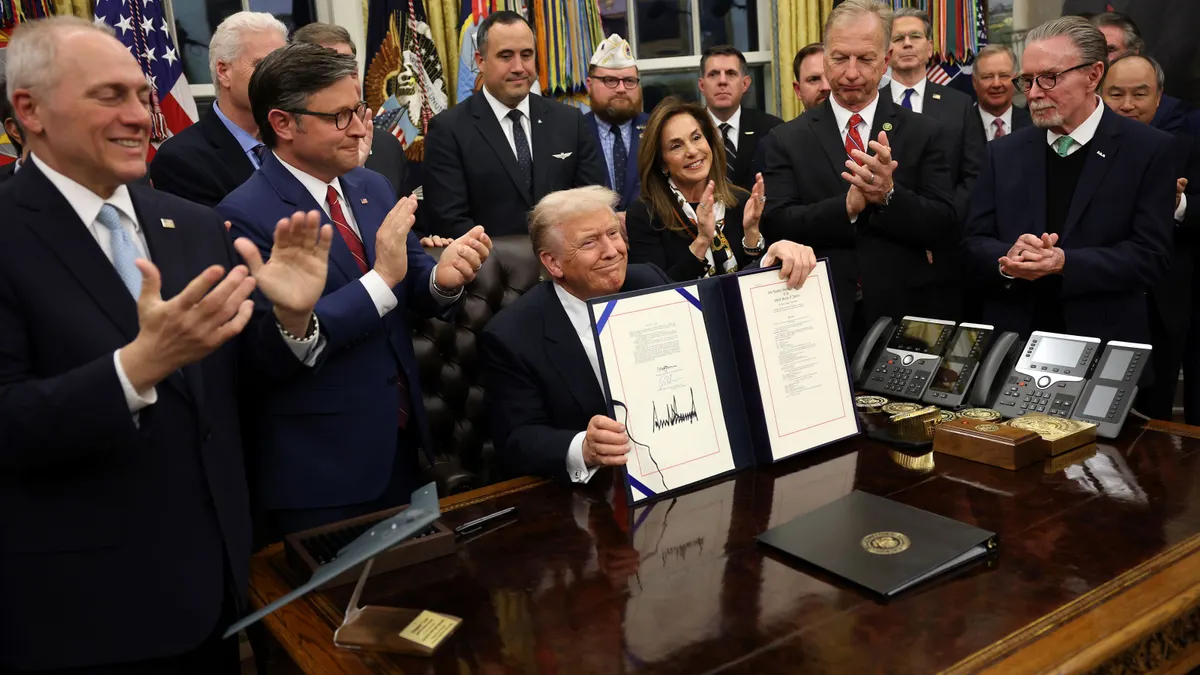This spring, the Trump administration renewed calls to bring drug manufacturing and production back to American shores, reigniting debate about what it will take to move onshoring from a lofty dream to reality.
In an executive order, President Donald Trump pushed to increase domestic production of prescription drugs, including active pharmaceutical ingredients and raw materials, by directing federal agencies to accelerate their approval process for building new domestic manufacturing facilities while enhancing inspections for foreign drug manufacturers.
Trump said the order was an effort to secure critical medical supply chains, but the administration’s focus on onshoring the drug supply chain is neither new nor strictly partisan. The federal government has deployed billions of dollars since the early 2010s to fund investments in pharmacy and drug manufacturing innovation. Events like the COVID-19 pandemic and other natural disasters have injected fresh urgency into the conversation, as the nation witnessed firsthand the ramifications of drug shortages on patient care.
“The pandemic limited flights for freight forwarding... There were huge challenges in terms of getting the product from point A to point B — that matters when we’re talking about disrupting drugs for patients with chronic conditions... where it’s vital they continue their medication,” said Maria Nieradka, research vice president in the healthcare and life sciences team at Gartner. “It demonstrated the importance of access and availability.”
Still, despite over a decade of political pressure to onshore, actually moving supply chains back home has proved vexing for the pharmaceutical industry, experts say.
High costs and onerous regulatory hurdles have been a barrier to onshoring, according to Jordan Brossi, senior public affairs advisor for law firm Holland & Knight.
There are costs to acquiring land for new facilities, long wait times to acquire permits and logistic complexities of moving the active pharmaceutical ingredient, or API, into its final container, she said. Then, companies have to factor in higher labor costs compared to overseas. Taken together, Brossi said that the total cost of producing domestically typically ran manufacturers almost 50% more than working with a foreign manufacturer.
“The cost-benefit is just not there for a lot of companies,” Brossi said.
However, pressure is mounting on companies to reconsider that analysis, she said, especially given the constant threat that Trump could levy tariffs on pharmaceuticals produced abroad. Already, some major players have announced commitments to move some production back home, including Thermo Fisher Scientific and Eli Lilly.
In the midst of all these challenges, technologists say their innovations might hold the key to helping other manufacturers follow suit.
They acknowledge that onshoring traditional manufacturing — which relies on making APIs in discrete quantities, or batches — is likely not cost effective for most companies. But they say public-private partnerships and private investment in advanced manufacturing has increasingly enabled innovation that will allow domestic manufacturers to compete with overseas suppliers.
“There is no way you can think about reshoring per se what has been done in China and India through building a batch manufacturing facility. There is a specific reason why this company went there, right? Because there is the low capital cost and the low human capital cost,” said advanced manufacturing firm Continuus Pharmaceuticals CEO Salvatore Mascia. “You can’t really replicate this model. Or if you do it, you will never be competitive, never be sustainable. The way to compete is by reshoring with innovation, that’s the key.”
Building supply chains for the future
The most viable solutions to bringing drug manufacturing back home will be both cost effective when deployed at scale and have buy-in from the Food and Drug Administration, said Steven Lupo, partner at the consultancy West Monroe.
The federal government has been working with researchers and private companies to help them harness such methods of production and supply chain management since the early 2010s, with increased investment flowing into the space in recent years.
Just last month, the Trump administration unveiled Equip-A-Pharma, a collaboration between the HHS, the Administration for Strategic Preparedness and Response, the Defense Advanced Research Projects Agency and the private sector to advance automation in pharmacy through artificial intelligence, machine learning and informatics.
“Manufacturing medicines from start to finish in the United States ensures a secure supply of essential medications,” said HHS Principal Deputy Assistant Secretary for Preparedness and Response John Knox in a statement. “Traditional pharmaceutical manufacturing is often too rigid and slow to adapt to changing demands, especially during national emergencies. We’re launching projects aimed at completely changing the approach not just to bring pharmaceutical manufacturing back to the U.S. but to do it better.”
Broadly, this advancement is called “Pharma 4.0,” Lupo said. It heavily involves integrating technology and includes everything from using AI to more accurately forecast demand — allowing companies to fully utilize manufacturing capacity and turn around batches faster — to building more facilities domestically or investing in point-of-care manufacturing, which produces cell or gene therapies where patients receive treatment.
Some drug manufacturers are using digital twins, or virtual replicas of their entire supply chain, to stay ahead of demand changes, said Nieradka. The companies give the AI models real-time data to simulate how an event, like a particularly virulent flu season, might impact production needs.
Other manufacturers, like Continuus Pharmaceuticals, are seeking to use technology to change the production process entirely. The company saw a problem with batch processing in pharmaceuticals, in which medications are created in a stop-and-start manner, with multiple discrete steps. The method is meant to allow for quality control after a batch has been produced, however Mascia told Healthcare Dive it’s ripe with inefficiencies.
His technology offers an end-to-end continuous process where active ingredients and formulations can be produced continuously.
“So you feed your raw material on your left, you collect your tablets at the other end without any more stop-start, under fully automated control with minimal human intervention,” Mascia said.
The Department of Defense saw promise in Continuus Pharmaceuticals, and awarded Mascia’s team nearly $70 million during the height of the pandemic to build the technology, stating it would help address the public health crisis at hand and allow for a more efficient delivery of care in future crises. The company plans to build their first domestic manufacturing plant this year, according to Mascia.
The manufacturer is hardly the only player the space. Pharmaceutical giants like AstraZeneca, for example, have also invested in the technology, according to Nieradka. AstraZeneca’s work on the continuous manufacturing of oral solid dose tablets helped reduce production time from several days to just 20 minutes.
“What they did is not only compress the cycle time of producing the product significantly, but they also reduced the footprint of their manufacturing site,” Nieradka said. “Those types of innovations are highly desirable, especially as you’re looking to power up new capability, because it could take you two to five years to build a manufacturing site.”
The FDA has been enthusiastic about continuous manufacturing, issuing initial guidance in 2020 meant to encourage manufacturers to harness similar technologies, before finalizing its guidance in 2023.
Point-of-care technologies, a specific form of continuous manufacturing that produces drugs on site at hospitals and clinics, are also attracting interest as therapies evolve to be more patient-specific and complex in delivery. The technology can be particularly useful for cell therapies, custom drugs or medications with short shelf lives, said Lupo.
Both carrot and stick still necessary to expedite change
Despite rapid technological advancements, the supply chain is unlikely to transform overnight without the proper incentives to encourage adoption, analysts warned. The pace of change will likely be years rather than months.
“Delivering therapies to patients is far different from making toys, right?” said Lupo, noting many in the pharmacy industry were also “laggards” when it came to deploying new tech.
Private investment could help speed up the onshoring timeline, said Lupo. For example, his firm has tracked an uptick in private equity interest in deals involving pharmacy automation this year, which he called a “flag in the wind” for the broader industry.
Favorable regulations on the federal level could also spur growth, according to Holland & Knight’s Brossi.
“This industry really likes certainty, and I think providing them certainty in the form of streamlined guidance and regulations... will be very helpful,” Brossi said. “But you can’t just flip a switch as a pharmaceutical company and say, ‘All right, I’m moving everything back to the U.S.’ You just can’t do it overnight.”
During a House Energy and Commerce subcommittee hearing held earlier this month, lawmakers weighed a range of policies to promote onshoring, and were split on whether incentives or penalties might best move the needle.
They considered expediting FDA review for new drugs, creating tax incentives for domestic production and incentivizing more public-private partnerships for generic domestic drug manufacturing to promote onshoring. Others supported requiring manufacturers to disclose which APIs are sourced abroad or bumping up scrutiny of overseas manufacturing facilities to make overseas production less desirable.
Meaningful regulatory support from the FDA could also decrease the time from planning to execution, said Brossi. However, experts wondered whether the FDA was up to the task.
Although the FDA has expedited drug reviews to meet national needs before, like during the COVID pandemic, recent layoffs by the Trump administration could hamper its efforts to onshore. For example, workers who previously would have issued guidance documents for the construction of new manufacturing facilities were impacted by the reduction in force, according to Brossi.
“This administration wants to do a lot, and they want to do it with not as many resources as have previously been used,” she said. “So not only are we asking them to continue to do really big things, but you’re giving them less resources than they’ve been used to.”






















